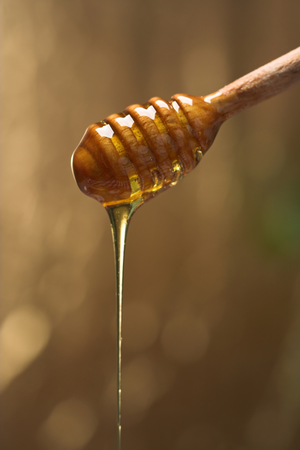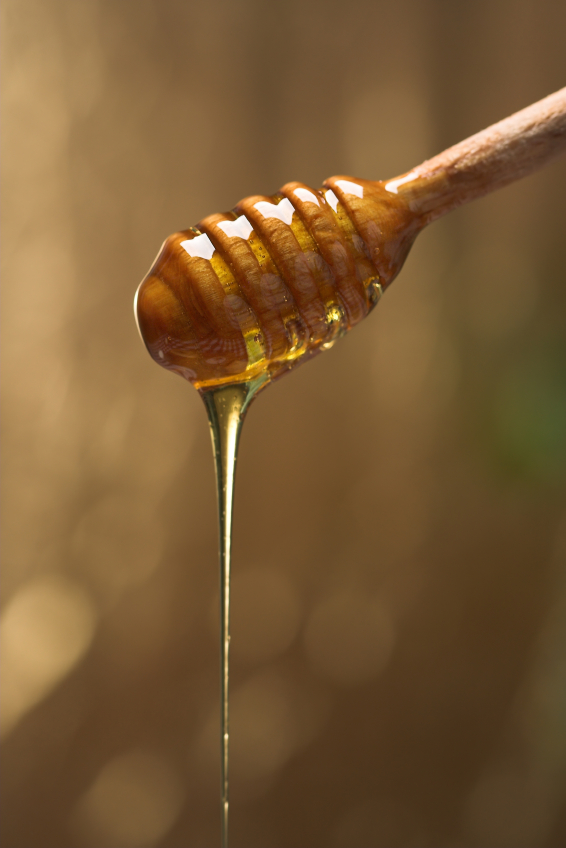Dripping Honey Explained
Spooning soft honey from a jar generates long, dangling threads of the liquid, but researchers have not understood why columns of a viscous fluid get so long without breaking up. In Physical Review Letters, a team explains the mystery using a combination of theory and experiments with dripping silicone oil. They found that while viscosity doesn’t affect the large-scale motion of the falling liquid very much—consistent with previous theories—it does affect the way that small, random waves in the fluid become amplified over time, which leads to breakup. The results may be relevant for industrial processes that involve pulling long strands of viscous fluid, such as the fabrication of optical fibers.
The fragmentation of a column of fluid into discrete droplets has been studied since the late nineteenth century. Belgian scientist Joseph Plateau and Englishman Lord Rayleigh explained that surface tension may accentuate fluctuations in diameter that develop randomly in the column, pinching it into drops. But it has remained puzzling that this breakup can be delayed in a falling jet of viscous fluid: a jet of water from a faucet typically fragments after about centimeters, whereas strands of honey can reach meters.
As the jet descends, the weight of the liquid stretches it until it is too thin to resist the growth of the fluctuations in diameter (the Rayleigh-Plateau instability). According to theory, this dropping and stretching process is essentially gravitationally driven and is unaffected by viscosity [1]. So the breakup point should be the same for all liquids.
Arman Javadi of the Ecole Normale Supérieure in Paris and his colleagues have now looked at the problem in more detail. They performed a so-called stability analysis on a mathematical model of a vertical liquid jet falling and stretching under gravity. They imposed wavy perturbations on the jet and checked whether the waves grew in amplitude or became smoothed away over time. “The challenge is that parameters are not constant during the growth of the perturbation,” explains team member Jens Eggers of the University of Bristol in the UK—the wavelength increases with time because of the stretching of the falling jet.
The researchers found that the breakup point does depend on viscosity; the key was to distinguish the different roles of viscosity. A high-viscosity liquid doesn’t significantly resist stretching of the falling column more than a low-viscosity one, but the greater viscosity does slow the amplification process for some perturbations.
For perturbations that start at the nozzle, this influence of viscosity doesn’t count for much, because they get rapidly stretched out as the jet descends, before they can grow and create pinch-off. But irregularities appearing further down the jet can grow in amplitude before they get stretched too much, so viscosity matters for them.
The researchers compared their predictions with experiments on silicone oils with a wide range of viscosities and found good agreement, except for the most viscous cases, where the theory over-estimates the breakup length. They think that at these viscosities the jets become so thin before they break that they are more susceptible to perturbations than the theory can describe.
Tomas Bohr, of the Technical University of Denmark in Lyngby, calls the work “a very clever and precise analysis.” Bohr’s previous study of the problem looked only at the limit in which perturbations become stretched to long wavelengths, where viscosity effects vanish [1].
Delayed breakup of liquid columns is important for the industrial process of fiber-spinning, where a viscous liquid such as a polymer or molten glass is drawn out into a long, thin strand to make textiles or optical fibers. The theory should help to predict the maximum length for such fibers, Eggers says.
Stretching of liquid jets also happens naturally in some volcanic environments, where molten rock is formed into glass fibers known as “Pele’s hair.” “This phenomenon shares with our falling viscous jets the elements of strong stretching and high viscosity,” says team member Neil Ribe of the University of Paris and the French National Center for Scientific Research (CNRS). “However, it also involves fast cooling and consequent strong increases in viscosity. This means that threads that have been stretched very thin will tend to solidify before they can break up.”
–Philip Ball
Philip Ball is a freelance science writer in London. His latest book is How Life Works (Picador, 2024).
References
- S. Senchenko and T. Bohr, “Shape and Stability of a Viscous Thread,” Phys. Rev. E 71, 056301 (2005)





